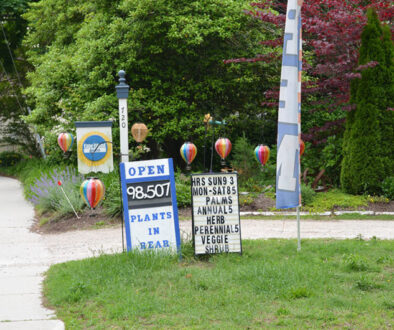Beauty, Versatility & Romance

Name this plant. You can wash with it, use it as perfume, drink it, and then use it to help you sleep. It can enhance your garden, decorate your dining table, and scent your underwear drawer. It can lower your heart rate, calm you down, and cure your headache. You can carry it in a bouquet on your wedding day. Plant it near your vegetable garden and it will keep away unwanted pests and attract pollinators to improve your harvest. It can also keep moths from nibbling at your sweaters and deter mosquitoes from biting you.
I’m sure the large photo gave you a hint. But if you don’t recognize it, the answer is lavender. It is by far the most versatile plant I have ever encountered, not to mention one of the most romantic.
While lavender is commonly referred to as a perennial, it’s actually an evergreen semi-woody shrub that can live eight to ten years depending on the variety and environmental conditions. Its fragrance ranges from floral to camphoraceous, which determines how each variety is used. Known for their famous purple flowers, not all lavender is lavender. There are some that are almost blue, pink, burgundy, white, and even yellow.
Varieties
Lavender (Lavendula) is a member of the mint family (Lamiaceae) which explains why deer, rabbits, and other rodents don’t like it. There are 28 known species and over 450 current cultivars. Be sure to choose the right variety depending on where you are growing it and how you intend to use it.
English lavender (L. augustifolia) is what you think of as classic lavender. Growing from one to three feet tall, it has narrow, silvery blue-green leaves and long spikes with small tight flowers that bloom from late spring to early summer. Because it is highly fragrant it is often used in perfume and cosmetics. And, due to its low camphor content, it is the best type of lavender for cooking. Some varieties can tolerate heat better than others, but all are relatively cold hardy. Varieties include: Munstead, Hidcote, and Vera.
English Hybrids or Lavandin (L. x intermedia) are crosses between the cold hardy English and heat tolerant Portuguese varieties. These plants are larger, grow faster, and produce more oil than their English cousins. Their long spikes of fragrant gray foliage produce blossoms from mid to late summer, making them the last group of lavenders to bloom. In fact, they only start as the English varieties finish. Although not good for culinary use, they are excellent when dried and used in sachets and potpourris. Varieties include Provence, Grosso, Hidcote Giant, and Phenomenal.
French lavender (L. dentata) Sometimes referred to as fringed lavender, French lavender is a bushy, spreading plant that grows two to three feet tall. It produces mildly fragrant, long-lasting flowers that have compact heads and purple bracts and bloom from early summer to fall. Its narrow, fine-toothed leaves have a rosemary-like scent. French lavender will tolerate humidity but prefers a milder climate than English lavender, i.e. no harsh winters. Varieties include Whimsical Fairy Wings, Avonview, and Goodwin Creek Grey.
Spanish lavender (L. stoechas) is small, only 18 to 24 inches tall and blooms from mid to late summer. Its unique pineapple-shaped blossoms have colorful bracts that are often referred to as “bunny ears”. Although the flowers are not particularly fragrant, its larger, silvery, light green leaves exude a eucalyptus-like fragrance that is often used in oils and potpourris. These plants are drought resistant and tolerate humidity better than other lavenders, making them perfect for Cape May. Varieties include: Anouk, Javelin Forte™, and Primavera.
In addition to Spanish lavender, Munstead, Hidcote, Phenomenal, Provence, and Sensational are good choices to grow here due to their hardiness and humidity resistance.

How to grow it
Lavender can be finicky, which is surprising since it requires so little attention. It likes full sun, well-drained soil, and just a little water. In fact, when it’s mature most lavenders are drought tolerant. You may want to add a little compost to our sandy soil when you plant it but otherwise skip additional fertilizers. It actually likes nutrient-poor soil. Lavender can succumb to fungal diseases like powdery mildew, so avoid overhead watering, plant it in a spot with good airflow, and select varieties that can tolerate our humid summers. Use small stones instead of regular mulch to ensure drainage and reduce humidity. Keep it blooming by dead heading and pruning in late summer or early fall. Reduce taller varieties by one third and cut shorter ones just a couple inches or down to new growth.
In Your Garden
Lavender makes a beautiful border and is spectacular when planted en masse if you have the space.
Its beautiful silvery blue foliage is stunning even when the plant is not in bloom. Plant it along a walk or driveway—it will love the reflected heat. Plant it near porches and patios and it will help to keep away unwanted pests like mosquitoes. It’s a great plant for a rock garden, a raised bed, in a container, or even on a slope.
Eating It
Lavender’s versatility continues. One of only a handful of spices that is at home in both sweet and savory recipes, you can add dried chopped buds to cookie and cake batters, preserves, or a jar of sugar. Sprinkle them on a salad. Infuse teas and cocktails with fresh lavender. Make your own herbs de Provence by adding marjoram, thyme, oregano, rosemary and savory and use it in soups, stews, or when roasting chicken and lamb.
Essential oil
The best essential oil is produced by steam distillation, but you can make it at home by simply infusing some olive, jojoba, or almond oil with your favorite dried buds. It won’t be as concentrated and it won’t last as long, but it’s simple and easy to do.
Cut your lavender right before the buds fully open. Georgeanne Wayman, owner of Cape May Lavender, recommends an English hybrid called Sensational that she grows right here in Cape May. Vera, Hidcote, Grosso, and Phenomenal are also excellent varieties to use. Hang the cut lavender upside down to dry for about a week. Gently crush the buds in your hands or with a rolling pin. Put them in a jar with the oil, cover tightly and shake gently. Put it in a sunny spot for about two to four weeks, shaking it again every few days. Strain the mixture through a cheesecloth and squeeze out all the oil you can. Store it in a dark bottle in a cool, dark place.

Where to see it growing
There are lavender farms you can visit in almost every state in the country. New Jersey is home to at least half a dozen—some sell plants, some allow you to pick your own bouquets. Still others have workshops, yoga classes, and gift shops. There are even entire festivals centered on this incredible plant. Here are a few places to get you started: Pleasant Valley Lavender in Morganville; Hidden Spring Lavender & Alpaca Farm in Skillman; Mad Lavender Farm in Milford; Orchard View Lavender in Port Murray; Field & Flock Lavender Farm in Woodstown; and Well-Sweep Herb Farm in Port Murray.
You can also enjoy the beauty of lavender as it grows right here in Cape May at the corner of Seashore Road and Oreo Way. Although you cannot pick your own at this lovely farmette, you can purchase products made with that lavender online at Cape May Lavender, EBay, and Etsy and at many Cape May retailers such as Cape Island Gardens, Cape May Antiques, and at Cape May Honey.
But if you want to experience lavender heaven, you need to go to France. The most iconic lavender fields in the world are located in Provence, where they bloom from mid-June through early August.
Elevate your garden and your life with the soothing beauty and calming essence of lavender.



